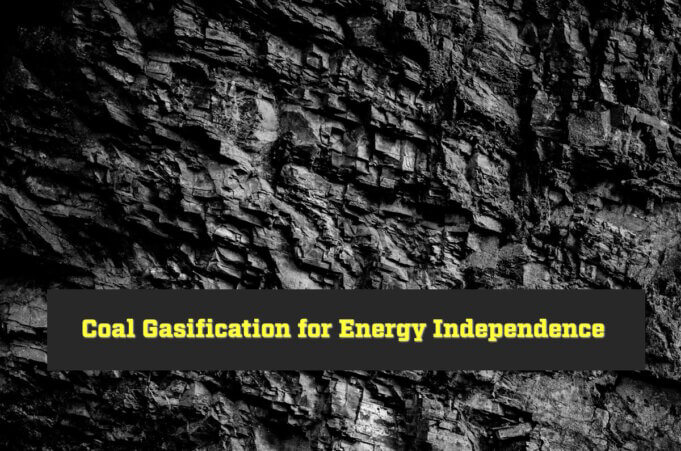India, with its vast coal reserves estimated at 378 billion tonnes, including approximately 199 billion tonnes classified as ‘proven,’ holds immense potential for energy production. Currently, around 80 percent of India’s coal consumption fuels thermal power plants. However, as the nation progresses towards a greener energy future, the Ministry of Coal is actively promoting the sustainable use of coal. In 2020, the Coal Gasification Mission was launched, aiming to gasify 100 million tonnes of coal by 2030. This initiative aligns with Prime Minister Shri Narendra Modi’s vision of achieving energy independence by 2027.
Coal Gasification: A Strategic Shift
Coal gasification is a thermo-chemical process that transforms coal into synthesis gas or “syngas,” composed mainly of carbon monoxide and hydrogen. With India relying heavily on imports for about 83 percent of its oil, over 90 percent of its methanol, and 13-15 percent of its ammonia, coal gasification presents a strategic opportunity to reduce import dependency and conserve foreign exchange. This process can diversify coal use, partially substitute imports for oil and gas, and enable cleaner utilization of India’s abundant coal reserves.
Recent Developments and Government Support
On 24 January 2024, the Cabinet Committee on Economic Affairs approved equity investments by Coal India Limited (CIL) to form joint ventures with BHEL and GAIL, exceeding the previous 30 percent equity limit. This initiative aims to demonstrate the financial and technical feasibility of gasification projects, stimulate markets for downstream products, and establish new economic value chains. The Ministry of Coal is also promoting coal gasification by offering a 50 percent rebate in revenue share in commercial auction policies for gasification coal. Additionally, a new sub-sector for syngas production has been established, and long-term coal allotments to gasification plants have been introduced.
Coal Gasification Scheme
- Financial Outlay: A total of Rs 8,500 crore has been allocated across three categories:
- Category I: Rs 4,050 crore for government PSUs, with up to three projects eligible for a financial incentive of Rs 1,350 crore per project, or 15 percent of Capex, whichever is lower.
- Category II: Rs 3,850 crore for the private sector and PSUs, with a financial incentive of Rs 1,000 crore per project, or 15 percent of Capex, whichever is lower.
- Category III: Rs 600 crore for demonstration projects and small-scale plants, with a financial incentive of Rs 100 crore per project, or 15 percent of Capex, whichever is lower.
- Selection Process: Category I involves a transparent selection process for Government PSUs/JVs, while Categories II and III utilize a transparent bidding process.
- Financial Incentives: Grants will be disbursed in two installments: the first after the bank loan disbursement and 30 percent equity contribution, and the second after achieving 50 percent production capacity and one year of continued production.
- Request for Proposals (RFPs): The Ministry has published the RFPs for providing financial incentives to coal gasification projects on May 15, 2024. Interested private sector entities and Government PSUs can register on the MSTC website to participate in the bidding process.
Major Projects Underway
Several significant projects are currently in progress through joint ventures and collaborations:
- CIL-BHEL JV Project in Lakhanpur, Odisha: The project focuses on producing ammonium nitrate with a capacity of 0.66 MMTPA, costing Rs 11,782 crore, and is expected to be commissioned by FY2029.
- CIL-GAIL JV Project in SonepurBazari, West Bengal: Aimed at converting coal into synthetic natural gas with a capacity of 1.83 MMSMD and costing Rs 13,052.8 crore, this project is also expected to be operational by FY2029.
- CIL-SAIL JV Project at Durgapur Steel Plant: The project aims to produce syngas for direct reduced iron, enhancing sustainability in steel manufacturing.
- NLCIL Lignite to Methanol Project: This initiative is developing clean energy products from lignite, including syngas, diesel, and green hydrogen.
- WCL Coal-to-Ammonium Nitrate Project: The project targets coal gasification into ammonium nitrate with a production capacity of 0.66 MTPA.
Pilot Project for Underground Coal Gasification
The Ministry of Coal has initiated India’s first pilot project for Underground Coal Gasification (UCG) at the Kasta coal block in Jharkhand. This pioneering effort represents a significant milestone for Coal India Limited (CIL) and its subsidiaries, placing India at the forefront of adopting advanced underground coal gasification technologies.
Call for Applications
The Ministry of Coal has invited applications for coal/lignite gasification projects from Government PSUs and private sector entities across all categories. This initiative is expected to unlock significant economic potential, boost revenues, and create new job opportunities. The deadline for bid submission is 11 November 2024.
A Promising Future
Coal gasification is emerging as a highly promising initiative, garnering enthusiastic responses from various sectors. The project not only presents a positive outlook for transforming coal into valuable products but also attracts significant interest from investors. With the potential to create numerous job opportunities and stimulate economic growth, coal gasification is set to revolutionize the industry, paving the way for a more sustainable and prosperous future in energy security.











